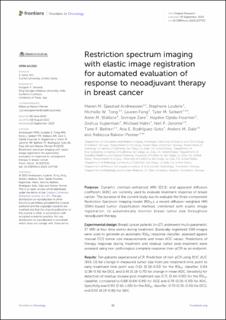| dc.contributor.author | Andreassen, Maren Marie Sjaastad | |
| dc.contributor.author | Loubrie, Stephane | |
| dc.contributor.author | Tong, Michelle W. | |
| dc.contributor.author | Fang, Lauren | |
| dc.contributor.author | Seibert, Tyler | |
| dc.contributor.author | Wallace, Anne M. | |
| dc.contributor.author | Zare, Somaye | |
| dc.contributor.author | Ojeda-Fournier, Haydee | |
| dc.contributor.author | Kuperman, Joshua | |
| dc.contributor.author | Hahn, Michael | |
| dc.contributor.author | Jerome, Neil Peter | |
| dc.contributor.author | Bathen, Tone Frost | |
| dc.contributor.author | Rodríguez-Soto, Ana E. | |
| dc.contributor.author | Dale, Anders | |
| dc.contributor.author | Rakow-Penner, Rebecca | |
| dc.date.accessioned | 2024-01-25T12:46:07Z | |
| dc.date.available | 2024-01-25T12:46:07Z | |
| dc.date.created | 2023-10-19T10:49:51Z | |
| dc.date.issued | 2023 | |
| dc.identifier.citation | Frontiers in Oncology. 2023, 13, 1237720 | en_US |
| dc.identifier.issn | 2234-943X | |
| dc.identifier.uri | https://hdl.handle.net/11250/3113846 | |
| dc.description.abstract | Purpose: Dynamic contrast-enhanced MRI (DCE) and apparent diffusion coefficient (ADC) are currently used to evaluate treatment response of breast cancer. The purpose of the current study was to evaluate the three-component Restriction Spectrum Imaging model (RSI3C), a recent diffusion-weighted MRI (DWI)-based tumor classification method, combined with elastic image registration, to automatically monitor breast tumor size throughout neoadjuvant therapy.
Experimental design: Breast cancer patients (n=27) underwent multi-parametric 3T MRI at four time points during treatment. Elastically-registered DWI images were used to generate an automatic RSI3C response classifier, assessed against manual DCE tumor size measurements and mean ADC values. Predictions of therapy response during treatment and residual tumor post-treatment were assessed using non-pathological complete response (non-pCR) as an endpoint.
Results: Ten patients experienced pCR. Prediction of non-pCR using ROC AUC (95% CI) for change in measured tumor size from pre-treatment time point to early-treatment time point was 0.65 (0.38-0.92) for the RSI3C classifier, 0.64 (0.36-0.91) for DCE, and 0.45 (0.16-0.75) for change in mean ADC. Sensitivity for detection of residual disease post-treatment was 0.71 (0.44-0.90) for the RSI3C classifier, compared to 0.88 (0.64-0.99) for DCE and 0.76 (0.50-0.93) for ADC. Specificity was 0.90 (0.56-1.00) for the RSI3C classifier, 0.70 (0.35-0.93) for DCE, and 0.50 (0.19-0.81) for ADC.
Conclusion: The automatic RSI3C classifier with elastic image registration suggested prediction of response to treatment after only three weeks, and showed performance comparable to DCE for assessment of residual tumor post-therapy. RSI3C may guide clinical decision-making and enable tailored treatment regimens and cost-efficient evaluation of neoadjuvant therapy of breast cancer. | en_US |
| dc.language.iso | eng | en_US |
| dc.publisher | Frontiers | en_US |
| dc.rights | Navngivelse 4.0 Internasjonal | * |
| dc.rights.uri | http://creativecommons.org/licenses/by/4.0/deed.no | * |
| dc.title | Restriction spectrum imaging with elastic image registration for automated evaluation of response to neoadjuvant therapy in breast cancer | en_US |
| dc.title.alternative | Restriction spectrum imaging with elastic image registration for automated evaluation of response to neoadjuvant therapy in breast cancer | en_US |
| dc.type | Peer reviewed | en_US |
| dc.type | Journal article | en_US |
| dc.description.version | publishedVersion | en_US |
| dc.source.volume | 13 | en_US |
| dc.source.journal | Frontiers in Oncology | en_US |
| dc.identifier.doi | 10.3389/fonc.2023.1237720 | |
| dc.identifier.cristin | 2186246 | |
| dc.source.articlenumber | 1237720 | en_US |
| cristin.ispublished | true | |
| cristin.fulltext | original | |
| cristin.qualitycode | 1 | |

